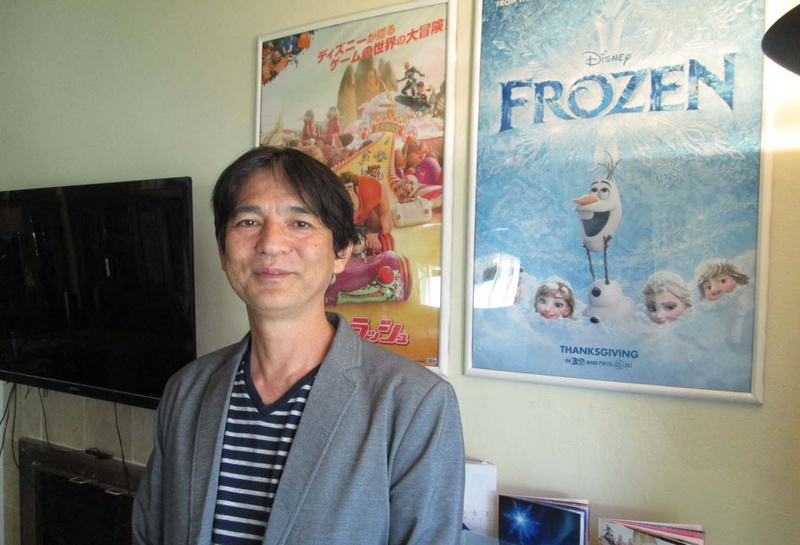I wanted to be an art teacher
When my daughter, who is now in the 8th grade, was in elementary school, we would always go to the cinema together to watch Disney animated movies. The one she was most fascinated with was "Tangled". And when she first saw it at the cinema, the name of a Japanese person appeared in the end credits, and I still remember how moved I was at that moment. However, I had forgotten about it for a while.
After that, "Frozen" became a big hit and won the Academy Award for Best Animated Feature Film in 2013. The modeler working on this film for Walt Disney Animation Studios was Hiroki Itokazu, a CG (computer graphics) artist born in Kumejima, Okinawa Prefecture in 1962, who is now the principal of an online CG school. When I met Itokazu for an interview to write this article, I was informed that he had modeled (created three-dimensionally) the main character Rapunzel in "Tangled." I was convinced that it was the same person whose name I had seen on the screen, and it brought back memories of the excitement I felt.
However, despite his brilliant track record as a CG artist in Hollywood, Itokazu himself is a very gentle and humble person. When I first asked him about his childhood spent on Kumejima, he replied, "We grew up in the countryside, so I spent my time relaxing in nature. After school, I went to the beach or the mountains. I didn't play with plastic models or watch anime. As for toys, I made my own stilts and bamboo-copters to play with. I was quite handy."
Aiming to become a junior high school art teacher in the future, he entered the art and craft department of the national university in the prefecture, University of the Ryukyus. However, while he was a student, he became interested in American product design (industrial design). His goal was to enter the top industrial design school, Art Center College of Design, recommended by a professor at University of the Ryukyus. The campus is located in Pasadena, a suburb of Los Angeles.
"Studying abroad was popular at the time, and I had relatives in America, so I started to think that I wanted to go and study in the home of industrial design. I thought I'd be able to do something if I went. So I went to America at the age of 24 after graduating from the University of the Ryukyus. I started out at Louisiana Tech University, where I began studying English with the goal of raising my TOEFL score so I could get into the Art Center. Why Louisiana? Because the tuition fees were cheap. The cultural gap I faced was that there were no doors on the toilets in the dorms. There were no doors on the toilets or the showers. They were all open. I heard that it was to prevent students from hiding and doing drugs inside. Other than that, I'd always liked food like hamburgers, so there was no gap for me."
He spent a year in Louisiana, but his TOEFL score did not improve as much as he had hoped. So he transferred to Gadsden Community College in Alabama for his second year. "It was the bubble era at the time, so even in a small college in a southern town, there were a lot of Japanese students. In fact, that's when I met my wife, who is from Kagawa Prefecture."
$20,000 Jackpot in Las Vegas
In his second year in Alabama, he also failed to reach his TOEFL goal, so in his third year he moved to Los Angeles, near an art center, and worked part-time at a sushi restaurant while studying English on his own.
"At that point, I had run out of money to study abroad. But my English scores still didn't improve, and I felt like I had no future. My parents told me to come back, and I was about to give up and return to Okinawa to become a middle school art teacher when something happened that changed my destiny."
After finishing his part-time job, he headed to Las Vegas. At around 3am, he put $1.50 into a slot machine and won $20,000.
"At the exchange rate back then, it was about 3 million yen. I thought, Wow! With this, I can cover my tuition fees. Even though I won $20,000, I had no intention of wasting it. Now it's a huge amount, but back then, tuition fees at the Art Center were about one-tenth of what they are now."
Furthermore, Itokazu's TOEFL score just barely met the required level for admission, and he was finally able to become a student at the Art Center of his dreams. "However, the university is so high-level that I first took a three-month night class before I was finally able to become an official student. I then used the credits I had earned at the University of the Ryukyus to graduate in three years."
Looking back, what impressed him most about his time at the Art Center was not only the top-notch instructors and the high level of the learning content, but also the high level of awareness among the students. "They were not just students at an art university, they were already aware of themselves as artists, and they worked on their projects."
Itokazu became interested in CG, which he learned as a required subject there, and after graduating he decided to enter the film industry, at a time when there were still very few CG artists. In 1993, he was hired as an apprentice by Warner Bros.
© 2016 Keiko Fukuda






